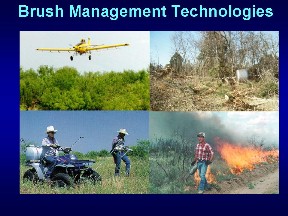 |
A very important research focus has been developing technology to manage woody plants such as mesquite and juniper (i.e., "brush management"), to provide multiple use options. This focus on brush is a direct result of clientele feedback, which cited brush encroachment as a key problem. We have developed a variety of technologies for manipulating brush, such as aerially applied herbicides and refinements in chaining, which elevates the chain to reduce drag. We also use lower cost techniques such as individual plant treatment with herbicides and prescribed fire for brush management. |
| These techniques are used to manipulate brush into different landscape patterns to develop different use strategies, ranging from complete removal of brush to produce a grassland setting for livestock production, to inclusion of thickets for wildlife habitat. A savanna, or a mixture of grassland and woody plants, supports both livestock and wildlife production. |
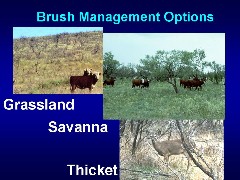 |
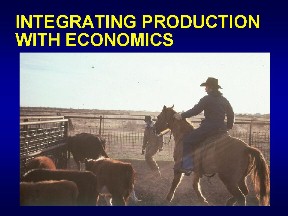 |
The fourth IRM component deals with the bottom line -- an integration of ranch-scale production with economics. This is being addressed with programs such as the SPA database and research at the ranch scale. SPA allows us to view real economics from real ranches, while ranch scale research assesses different options at the whole ranch business level. |
Numerous research projects are conducted to achieve our mission. We partner with a number of ranches to conduct this research. |
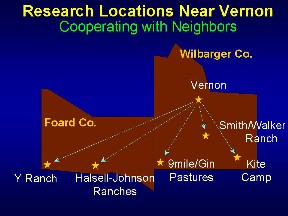 |
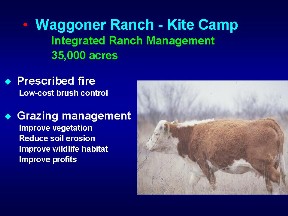 |
We conduct whole-ranch systems research on the Kite Camp of the Waggoner Ranch. Here we measure economic and ecological responses with a livestock production system using whole ranch accounting and accounting for natural resources. there are often hidden costs to production from rangelands such as losses in soil fertility or distribution of noxious seeds or insects that we need to measure and eventually analyze in the same currency as we do traditional economics. Grazing is managed to provide fuel for low-cost prescribed fire to be used to reduce brush. Grazing management is also utilized to improve rangeland health and wildlife habitat. |
| On the Smith-Walker Ranch forage testing and cattle movement studies are conducted. Cattle are fitted with GPS collars to improve our understanding of livestock movement patterns with the goal of improving grazing distribution in a pasture. |
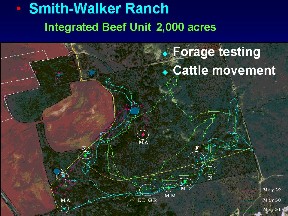 |
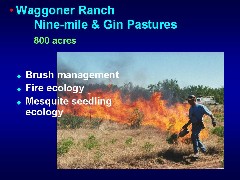 |
On the Nine-mile and Gin pastures of the Waggoner Ranch work is being done to improve the efficiency and efficacy of different brush managed tools and improve our understanding of fire behavior so we can better predict fire effects on rangeland and design fire prescriptions to meet management goals. This also helps make fire a safer tool to use. Work on mesquite ecology is being conducted to enhance our ability to manage this plant for different objectives. |
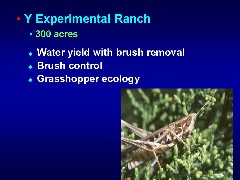 |
On the Y Experimental ranch we conduct research on the effect of brush removal on water runoff and associated soil erosion. WE have characterized the grass-feeder and mixed-feeder grasshoppers for these mesquite and juniper vegetation communities. |
| On the Halsell and Johnson ranches we are investigating the efficacy of juniper removal and follow-up prescribed burning in terms of reducing cedar fly habitat as a means of controlling cedar fly populations. |
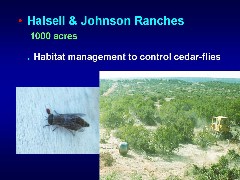 |
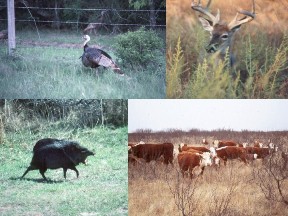 |
New projects are in the planning stages on Crowell Brine Lake property and the adjacent Triangle Ranch. We hope to study habitat selection by wildlife in response to livestock and brush management. We are preparing to study the effects of different grazing and brush management strategies on restoration of plant composition and ecosystem health of range that has been degraded during the recent succession of drought years. |
| Other new projects include integrating cropland and improved forages into native rangeland livestock production systems. |
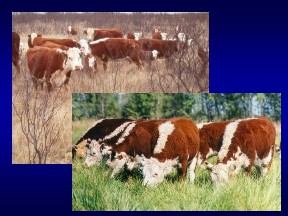 |





















